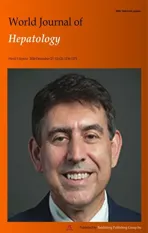Autophagy related protein 9A increase in hepatitis B virusassociated hepatocellular carcinoma and the role in apoptosis
2021-01-13IngornKimkongAreeratKunanopparat
Ingorn Kimkong, Areerat Kunanopparat
Ingorn Kimkong, Department of Microbiology, Faculty of Science, Kasetsart University, Center for Advanced Studies in Tropical Natural Resources, National Research University – Kasetsart University, Bangkok 10900, Thailand
Areerat Kunanopparat, Department of Microbiology, Center of Excellence in Immunology and Immune Mediated Diseases, Chulalongkorn University, Bangkok 10330, Thailand
Abstract The majority of hepatocellular carcinoma (HCC) cases are associated with the hepatitis B virus (HBV) infection.Autophagy related protein 9A (ATG9A) is a transmembrane protein required for autophagosome formation.In order to investigate the role of ATG9A in HBV-associated HCC, ATG9A protein expression was determined in tumor liver tissues and compared with adjacent nontumor tissues from HCC patients with or without HBV infection.In HBVassociated HCC tissues, ATG9A protein level was increased in tumor liver tissues, but not in cases of non-HBV HCC.Our findings suggested that ATG9A might be involved in HBV and cancer cell survival.Therefore, we aimed to analyze the function of ATG9A in HBV replication using RNA interference to evaluate the HBV DNA level using real-time PCR.In the present study, there were no significant differences between shATG9A-transfected HepG2.2.15 cells and the mock control.However, we found that silencing ATG9A affected apoptosis in HepG2.2.15 and HepG2 cell lines.Our results indicated that ATG9A might be partly involved in the survival of HCC.Thus, the inhibition of ATG9A together with other targets might be a potential drug target for HCC treatment.
Key Words: Autophagy; Hepatitis B virus; Hepatocellular carcinoma; Autophagy related protein 9A; Apoptosis; HBx
TO THE EDITOR
Autophagy related protein 9A (ATG9A) is a transporter membrane molecule required for initial autophagosome formation in the autophagy pathway[1].ATG9A has been identified as having the function of a stimulator of interferon (IFN) genes (STING)inhibition.A loss of ATG9A results in enhanced assembly of STING/TANKbinding kinase 1 complexes in response to dsDNA, leading to an increase in innate immune responses[2].Silencing of ATG9A in macrophages increases STING-mediated IFN-β production and promotes cell viability[3].Our previous study reported that gene and protein expressions of ATG9A were upregulated in HepG2 and HepG2.2.15 cells compared with a THLE-2 hepatic cell line[4].Thus, in this study we investigated the role of ATG9A in hepatitis B virus (HBV)-associated hepatocellular carcinoma (HCC) tissues.We found that ATG9A protein levels were highly increased in tumor liver tissues in HBV-associated HCC (9 of the 10 sample pairs).In the case of non-HBV HCC, ATG9A protein levels were decreased or slightly increased in tumor liver tissues (Figure 1).Therefore, we hypothesized that HBV induces the upregulation of ATG9A to benefit its replication.To determine the effect of ATG9A on HBV replication, HBV DNA was quantified from shATG9A-transfected cells and compared to mock cells.We observed no significant difference in shATG9A transfected cells (Figure 2).
HBV induces autophagyviathe HBx protein and is directly involved in starvationinduced autophagyviaupregulation of Beclin-1 expression[5].HBx also binds and activates phosphatidylinositol 3-kinase class III for autophagy induction[6].Our study showed that overexpression of HBx did not affect ATG9A expression (Figure 3), suggesting that the function of ATG9A may not involve HBV replication or viral clearance.
Autophagy is involved in tumor progression and tumor suppression.Several studies have shown that HBV induces autophagy for cell survival in an unsuitable environment[7].In order to search for the effect of ATG9A on apoptosis, we performed flow cytometry in HepG2.2.15 cells and compared against HepG2 cells after ATG9A silencing.We found that silencing ATG9A increased apoptosis in both cell lines (Figure 4), suggesting that ATG9A is involved in cell apoptosis related to HCC.
In conclusion, we provide information that ATG9A is highly expressed in HBVassociated HCC tissue samples and plays a role in cell apoptosis.Further studies are needed to investigate the mechanism of ATG9A-mediated inhibition of apoptosis in HCC.

Figure 1 Quantification of autophagy related protein 9A protein levels from hepatitis B virus-infected hepatocellular carcinoma patients and nonhepatitis B virus hepatocellular carcinoma patients.

Figure 2 Silencing of autophagy related protein 9A by RNA interference and detection of hepatitis B virus DNA level.

Figure 3 Quantitative real-time reverse transcriptase-PCR analysis of autophagy related protein 9A mRNA expression in HepG2-GFP and HepG2-HBx transfected cell lines.

Figure 4 Apoptosis assays of HepG2 and HepG2.2.15 transfected with sh-autophagy related protein 9A or shNeg (control).
ACKNOWLEDGEMENTS
We are grateful to all the patients who participated in this study.We would like to thank Tangkijvanich P and Sirichindakul B for tissue biopsy collection and Hirankarn N for valuable advice.
杂志排行
World Journal of Hepatology的其它文章
- Hepatitis E virus re-infection accelerates hepatocellular carcinoma development and relapse in a patient with liver cirrhosis: A case report and review of literature
- Successful hepatic resection for recurrent hepatocellular carcinoma after lenvatinib treatment: A case report
- Safety and efficacy of sofosbuvir/velpatasvir/voxilaprevir in postliver transplant patients with previous direct-acting antiviral failure:Six case reports
- Subclinical proximal tubulopathy in hepatitis B: The roles of nucleot(s)ide analogue treatment and the hepatitis B virus
- HIPPOCRATES® project: A proof of concept of a collaborative program for hepatitis C virus microelimination in a prison setting
- Effect of non-alcoholic beer, diet and exercise on endothelial function, nutrition and quality of life in patients with cirrhosis
